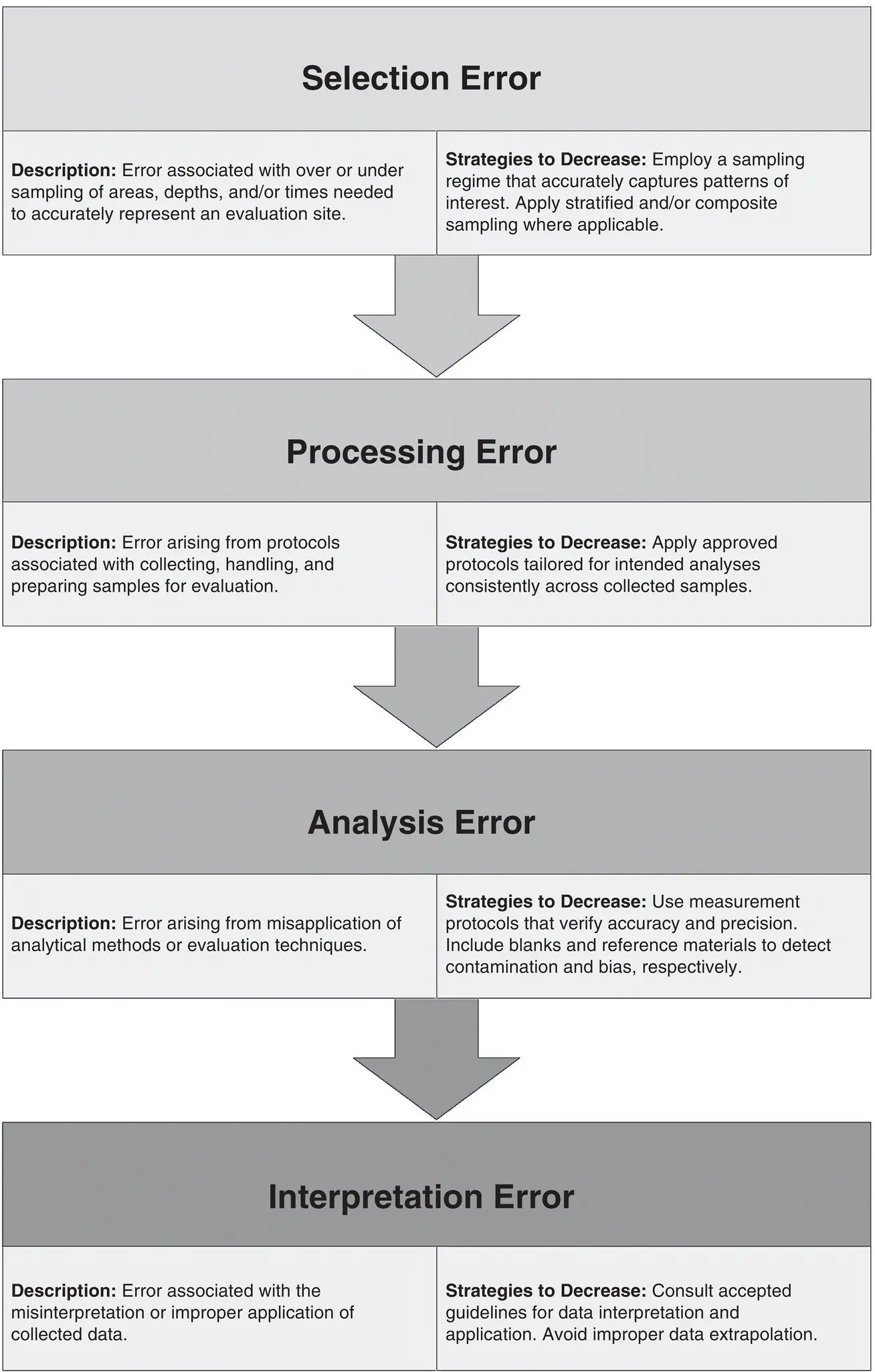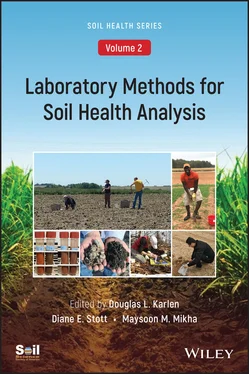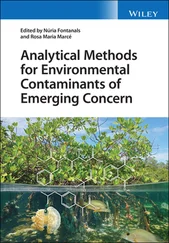Laboratory Methods for Soil Health Analysis, Volume 2
Здесь есть возможность читать онлайн «Laboratory Methods for Soil Health Analysis, Volume 2» — ознакомительный отрывок электронной книги совершенно бесплатно, а после прочтения отрывка купить полную версию. В некоторых случаях можно слушать аудио, скачать через торрент в формате fb2 и присутствует краткое содержание. Жанр: unrecognised, на английском языке. Описание произведения, (предисловие) а так же отзывы посетителей доступны на портале библиотеки ЛибКат.
- Название:Laboratory Methods for Soil Health Analysis, Volume 2
- Автор:
- Жанр:
- Год:неизвестен
- ISBN:нет данных
- Рейтинг книги:3 / 5. Голосов: 1
-
Избранное:Добавить в избранное
- Отзывы:
-
Ваша оценка:
- 60
- 1
- 2
- 3
- 4
- 5
Laboratory Methods for Soil Health Analysis, Volume 2: краткое содержание, описание и аннотация
Предлагаем к чтению аннотацию, описание, краткое содержание или предисловие (зависит от того, что написал сам автор книги «Laboratory Methods for Soil Health Analysis, Volume 2»). Если вы не нашли необходимую информацию о книге — напишите в комментариях, мы постараемся отыскать её.
Analyzing, comparing, and understanding soil health data Soil Health, Volume Two: Laboratory Methods for Soil Health Analysis
Laboratory Methods for Soil Health Analysis, Volume 2 — читать онлайн ознакомительный отрывок
Ниже представлен текст книги, разбитый по страницам. Система сохранения места последней прочитанной страницы, позволяет с удобством читать онлайн бесплатно книгу «Laboratory Methods for Soil Health Analysis, Volume 2», без необходимости каждый раз заново искать на чём Вы остановились. Поставьте закладку, и сможете в любой момент перейти на страницу, на которой закончили чтение.
Интервал:
Закладка:
Regardless of the chosen approach, a common requirement of all is to accurately assess the condition of a soil, which is an inherently complex medium varying across space and time. To address this complexity, evaluators must consider a series of questions dealing with location, timing, frequency, and sampling protocol that will affect the quality and usefulness of collected data.
Table 2.1 Synthesis of select resources addressing sampling considerations and field evaluations for soil health assessment.
| Citation | Title | Topics addressed |
|---|---|---|
| Pellant et al. (2020) | Interpreting indicators of rangeland health | Review of protocols for assessing ecosystem function on rangelands and woodlands. Provides assessment and interpretive guidelines for soil‐associated measurements. |
| Ball et al. (2017) | Visual soil evaluation: A summary of some applications and potential developments for agriculture | Review of visual soil evaluation methods, with emphasis on the Visual Evaluation of Soil Structure (VESS). Addresses VESS applications to agricultural production and environmental quality. |
| USDA‐NRCS (2001) | Soil quality test kit guide | Review of assessments made with the Soil Quality Test Kit. Background and interpretive guidelines provided for each assessment. |
| Boone et al. (1999) | Soil sampling, preparation, archiving, and quality control | Review of protocols for soil sampling and laboratory processing. Guidelines developed for the U.S. Long‐Term Ecological Research Network. |
| Dick et al. (1996) | Standardized methods, sampling, and sample pretreatment | General guidelines for soil sampling, sample handling, and quality assurance/control. |
| Sarrantonio et al. (1996) | On‐farm assessment of soil quality and health | Review and application of measurements made by the Soil Quality Test Kit. Results from case studies provided. |
| Petersen and Calvin (1986) | Sampling (Methods of soil analysis) | Addresses statistical considerations of different sampling approaches. |
This chapter provides general guidelines for collecting soil health samples and reviews select descriptive and analytical field evaluations. For more in‐depth discussion, readers should see Pellant et al. (2020), Ball et al. (2017), USDA‐NRCS (2001), Boone et al. (1999), Dick et al. (1996), Sarrantonio et al. (1996), or Petersen and Calvin (1986), synthesized in Table 2.1.
Soil Variability
Spatial variation across landscapes (horizontal) and throughout the profile (vertical) is caused by differences in soil genesis and development, resulting in inherent differences in color, physical structure, texture, and chemical attributes (Soil Science Division Staff, 2017). Inherent soil property differences provide the foundation for classifying soils using various taxonomic schemes (e.g., FAO, USDA). This “natural variation” can be gradual or abrupt across landscapes and depth increments, underscoring the necessity for preliminary site assessments before initiating full‐scale sampling efforts (Boone et al., 1999).
In most agroecosystems, inherent spatial soil variation is coupled with management‐induced variation, as reflected by horizontal and/or vertical zones having similar soil properties. Management‐induced variation typically reflects long‐term repeated use of tillage, chemical amendments, controlled traffic (vehicular and animal), irrigation practice, or crop residue removal (Boone et al., 1999). These induced characteristics can often mask inherent variation in soil properties (Wang et al., 2019). Consequently, sources of management‐induced variation must be understood before conducting a soil health assessment. Furthermore, depending upon the evaluator’s goals, it may be necessary to subdivide the sampling area into uniform zones to accurately assess management‐induced variation (Dick et al., 1996).
All soil properties change over time in response to environmental‐ and management‐related factors. Soil properties strongly influenced by temperature and moisture can fluctuate daily, while those reflecting inherent properties (e.g., texture, mineralogy) change slowly. Though land managers have negligible control over weather and soil forming factors, management decisions, including application of chemical amendments, tillage type and intensity, crop rotation, biomass harvest, and animal activity, can induce significant variation in soil properties (Wuest, 2015; Boone et al., 1999).
Among the portfolio of soil health indicators, those associated with soil biological activity are influenced by daily and seasonal weather changes and management practices that influence nutrient cycling, carbon balance, and physical conditions (Liebig et al., 2006; Dick et al., 1996). As soil health assessments have evolved to include more biological properties and processes (Bünemann et al., 2017), it is imperative evaluators account for temporal dynamics when collecting samples.
Sampling Considerations
Sources of Error
Obtaining an accurate depiction soil health underscores the importance of minimizing errors during each step of an evaluation. Errors are cumulative, beginning with decisions made during site selection and ending with the interpretation of collected data ( Fig. 2.1). Understanding error types associated with an evaluation can guide decisions to reduce their influence on observed outcomes (Dick et al., 1996).
Selection error is associated with the over or under sampling of areas, depths, and/or times needed to accurately represent a site ( Fig. 2.1). Sources associated with this type of error (also referred to as sampling error) are well known (Das, 1950). This error can be minimized by using a sampling plan that accurately captures patterns of interest. Selection error can also be reduced by increasing the number of samples collected within or among subareas if using a stratified sampling approach (see below).

Figure 2.1 Error components associated with soil property assessment.
Processing error are errors made while collecting, handling, and preparing samples for evaluation ( Fig. 2.1). Reducing this error requires consistent application of approved protocols tailored for the specific type of analyses, inclusive of storage conditions. Closely aligned with processing error is measurement error, which arises from an improper application of analytical methods or evaluation techniques. Consistent use of consensus protocols will ensure accuracy and precision of each measurement. For laboratory analyses, use of blanks, internal standards, and reference samples is necessary to detect potential contamination and bias.
Once data have been collected, interpretation error can further confound errors from site selection, sample processing, and measurement ( Fig. 2.1). Interpretation error results from accidental or systematic misinterpretation or improper application of data. Reduction of interpretation error relies on the evaluator’s knowledge to accurately decipher data in context to the sampled site, while concurrently ensuring data outcomes are not extrapolated beyond inherent spatiotemporal constraints or methodological limitations.
Site Characterization
Preliminary site characterization is important and encouraged, especially when spatial variation of inherent soil properties and/or previous land use is unknown. If the site is intended for long‐term monitoring, preliminary site characterization is essential. Referencing maps and/or imagery of the site prior to in‐field assessments may elicit attributes not visible from the ground. Preliminary field assessments can be made rapidly using hand probes, augers, or a shovel to identify variation in morphological attributes. More intensive profile assessments will provide additional information but will increase the investment of time and labor. Profile assessments are especially useful if framed by knowledge of pedogenic processes (Boone et al., 1999), recognizing such assessments are generally beyond the scope of most soil health assessments. Characterizing site geomorphology, however, may be helpful for interpreting landscape attributes and their relationship to ecosystem processes (Gringal et al., 1999).
Читать дальшеИнтервал:
Закладка:
Похожие книги на «Laboratory Methods for Soil Health Analysis, Volume 2»
Представляем Вашему вниманию похожие книги на «Laboratory Methods for Soil Health Analysis, Volume 2» списком для выбора. Мы отобрали схожую по названию и смыслу литературу в надежде предоставить читателям больше вариантов отыскать новые, интересные, ещё непрочитанные произведения.
Обсуждение, отзывы о книге «Laboratory Methods for Soil Health Analysis, Volume 2» и просто собственные мнения читателей. Оставьте ваши комментарии, напишите, что Вы думаете о произведении, его смысле или главных героях. Укажите что конкретно понравилось, а что нет, и почему Вы так считаете.












